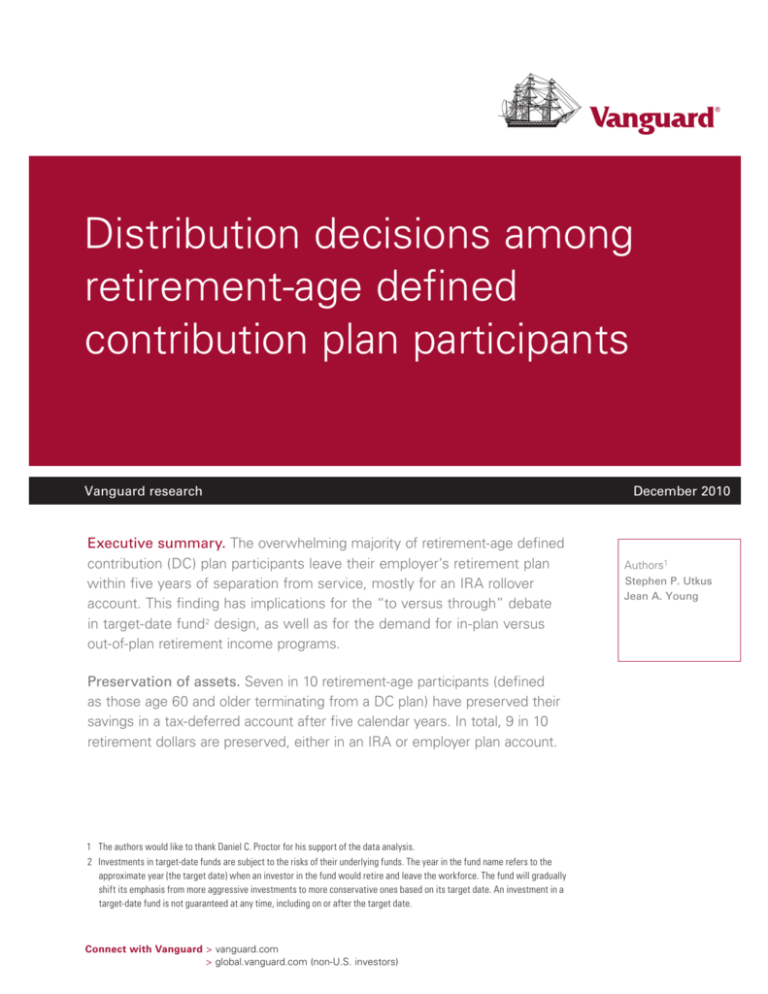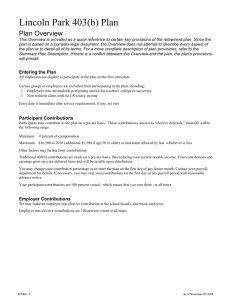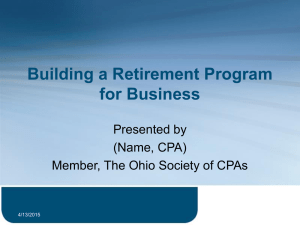
Distribution decisions among
retirement-age defined
contribution plan participants
Vanguard research
Executive summary. The overwhelming majority of retirement-age defined
contribution (DC) plan participants leave their employer’s retirement plan
within five years of separation from service, mostly for an IRA rollover
account. This finding has implications for the “to versus through” debate
in target-date fund2 design, as well as for the demand for in-plan versus
out-of-plan retirement income programs.
Preservation of assets. Seven in 10 retirement-age participants (defined
as those age 60 and older terminating from a DC plan) have preserved their
savings in a tax-deferred account after five calendar years. In total, 9 in 10
retirement dollars are preserved, either in an IRA or employer plan account.
1 The authors would like to thank Daniel C. Proctor for his support of the data analysis.
2 Investments in target-date funds are subject to the risks of their underlying funds. The year in the fund name refers to the
approximate year (the target date) when an investor in the fund would retire and leave the workforce. The fund will gradually
shift its emphasis from more aggressive investments to more conservative ones based on its target date. An investment in a
target-date fund is not guaranteed at any time, including on or after the target date.
Connect with Vanguard >
vanguard.com
> global.vanguard.com (non-U.S. investors)
December 2010
Authors1 Stephen P. Utkus
Jean A. Young
In-plan behavior. Only about one-fifth of retirement-age participants and one-fifth of assets
remain in the employer plan after five calendar years following the year of termination. In other
words, most retirement-age participants and their plan assets leave the employer-sponsored
qualified plan system over time.
Cash-out of smaller balances. Three in 10 retirement-age participants take cash distributions
from their employer plan over the subsequent five calendar years. Older participants cashing
out their entire plan balance tend to have smaller balances; the average amount cashed out
is approximately $20,000. By comparison, retirement-age participants remaining in their plan,
rolling over to an IRA, or pursuing a combination of strategies have average balances ranging
from $150,000 to $250,000.
Impact of market environment. Our analysis includes older participants terminating
in 2008, a year marked by a global financial crisis and a severe decline in stock prices.
Somewhat surprisingly, the behavior of retirement-age participants in 2008 was similar
to that of earlier years.
Implications. These findings have implications for the design of target-date funds and
retirement income programs. The tendency of participants to preserve plan assets at
retirement supports the notion of “through” glide paths in target-date fund design. In other
words, target-date designs should encourage an investment strategy at retirement that
recognizes assets are generally preserved for several years post-retirement age. There is
no evidence of widespread use of assets for immediate cash spending at retirement. Also,
with the rising importance of lump-sum distributions, participants will need assistance in
translating these pools of saving into a regular income stream. Based on current retirementage participant behavior, most of these retirement income decisions will be made in the IRA
marketplace, not within employer-sponsored qualified plans.
2
Background
As DC plans have emerged as the dominant type
of private-sector retirement plan, policymakers,
plan sponsors, and providers have increasingly
focused attention on the distribution decisions
older participants make when they stop working.
Participant behavior at retirement age is of particular
interest in addressing two contemporary questions:
First, should the glide path of target-date funds
be based on a “to retirement” or a “through
retirement” approach? The former would suggest
a more conservative glide path, assuming assets
are used immediately at retirement; the latter, an
investment strategy that recognizes that assets are
generally preserved for several years post-retirement
age. Second, should retirement income programs—
designed to help participants translate account
balances into income streams—be offered within
qualified retirement plans? Or is the IRA rollover
marketplace the more likely destination for plan
assets in retirement?
Figure 1.
To better understand the decisions made by
participants at retirement, this paper examines
the decisions made by participants age 60 and
older who separated from service with their
employer. For convenience, we define this group
as “retirement-age” participants—although some
will have separated from service with one employer
only to continue to work with another.
Data characteristics
The data for this analysis comes from Vanguard’s
DC recordkeeping clients over the period January 1,
2004, through December 31, 2009. We examine the
plan distribution behavior through year-end 2009 of
133,300 participants age 60 and older who terminated
employment in calendar years 2004 through 2008
(Figure 1). The average account balance of participants
in this sample ranged from $110,000 to $148,300,
depending on the year of termination.
Participants age 60 and older by year of termination
Number of participants
Average balances*
Year of termination
2004
19,800 $110,400
2005
22,300 $123,900
2006
25,500 $128,900
2007
30,700 $142,500
2008
35,000 $148,300
All
133,300
$133,500
*At year-end prior to year of termination.
Source: Vanguard, 2010.
3
Approximately half of the participants in our sample
had account balances of less than $50,000 (Figure 2) ,
depending on the year of termination. Three in 10
retirement-age participants had worked for the plan
sponsor less than nine years—one factor affecting the
number of smaller balances, since account balances
rise with tenure. About 45% of retirement-age
participants had 20 years or more of job tenure.
These longer-tenured participants had average
account balances of about $200,000.
Distribution options
DC plan participants who separate from service with
an employer may choose among several options.
They may:
• Remain in their employer’s plan.3
• Roll over their assets to an IRA.
Over the 2004–2009 period, approximately two-thirds
of participants age 60 and older who terminated employ‑
ment chose a single option (i.e., 100% of their account
disbursements fell into a single category); one-third
chose a combination of the three distribution options.
In our analysis, we categorized participants based on
whether 80% or more of their account disbursements
fell into a particular category. We categorized
participant assets based on both the participant
category and the actual dollar flows. For example,
suppose three years after termination, a participant
had taken a cash distribution equal to 15% of his or
her account balance, with 85% of assets remaining
in his or her plan account. The participant would be
classified as remaining in the plan in our analysis
of participant behavior. In our analysis of aggregate
asset flows, 15% is categorized as “cash” and 85%
as “remaining in the plan.”
• Take their account balance in cash.
• Pursue a combination of the above strategies.
In analyzing those remaining in their employer’s plan,
we separately distinguished those who remained in
their employer’s plan and also established installment
payments from their account. Eighty-eight percent of
plans on the Vanguard recordkeeping system allow
participants to establish installment payments—
regular monthly, quarterly, or annual payments—
from their accounts.
We created a “combination” category for participants
whose behavior could not be classified according to
the 80% rule. For example, if a participant cashed
out 50% of assets and rolled over 50% of assets to
an IRA, he or she was classified as a “combination”
participant because neither strategy (cash-out
or rollover) dominated the distribution decision
by exceeding 80% of assets. In our analysis of
aggregate asset flows, the assets are classified
based on actual flows—50% rollover and 50%
cash distribution.
3 Plan sponsors have the option of requiring participants with balances of less than $5,000 to leave the plan. If the balance is greater than $1,000 and
the participant doesn’t make a distribution election, the plan sponsor must roll over the balance to an IRA; balances of less than $1,000 can be distributed
in cash (i.e., as a check payable to the participant).
4
Account balance and tenure characteristics
Figure 2.
Participants age 60 and older by year of termination
Year of termination
2004
2005
2006
2007
2008
All
Account balance (end of year prior to year of termination)
<$10,000
21%
20%
19%
19%
21%
20%
$10,000­­–$24,999
15
13
13
12
12
13
$25,0000­­–$49,999
15
15
14
14
13
14
Subtotal: <$50,000
51
48
45
45
46
47
$50,0000­­–$99,999
18%
18%
18%
16%
16%
17%
$100,0000­­–$249,999
20
21
22
23
21
21
$250,000+
11
14
14
16
17
15
Subtotal: $50,000 or more
49
52
54
55
54
53
Job tenure (years, end of year prior to year of termination)
<3 11%
11%
11%
11%
13%
11%
4–9 19
20
21
20
20
20
10­­–19 24
24
23
24
24
24
20+
46
45
45
45
43
45
$24,800 $26,900
Average account balance by job tenure <3 $24,500 4–9 $28,400 $28,100 $29,200 51,500 50,600 54,200 65,300 67,000 59,100
10­­–19
100,300 111,600 118,300 127,200 126,900 118,800
20+
159,500 185,100 191,800 211,900 234,100 201,200
Source: Vanguard, 2010.
5
Figure 3.
Participant distribution behavior as of year-end 2009
Participants age 60 and older by termination year
xxxxxxxxxxxxxxxxxxxx Year of termination
2004
2005
2006
2007
2008
Percentage of participants at year-end 2009
Remain in plan
11%
13%
16%
19%
27%
Installments
4
3
2
2
2
Rollover
57
59
58
55
47
Preserved for retirement 72
75
76
76
76
Combination
Cash
6%
22
5%
20
5%
19
5%
19
5%
19
Percentage of assets at year-end 2009
15%
17%
20%
30%
Installments
Remain in plan
14%
7
5
3
3
2
Rollover
68
70
70
67
58
Preserved for retirement 89
90
90
90
90
Combination
7%
7%
7%
7%
7%
Cash
4
3
3
3
3
Note: December 31, 2009, value for assets remaining in the plan plus actual transaction value for assets distributed from the plan. Participants are categorized as cash,
rollover, and installments if greater than 80% of their account disbursements fell into these categories. Participants are categorized as remain in plan if more than 80% of
their account balance remains in the plan. All other participants were categorized to the combination category as one disbursement type did not dominate their account
disbursements and less than 80% of their account remains in the plan. Source: Vanguard, 2010.
Participant distribution decisions
Our analysis approach is based on calendar year
cohorts. Participants terminating in each of the
calendar years in our sample, 2004 through 2008,
are considered a distinct cohort, and are followed
separately through year-end 2009. Thus, the 2004
cohort, which consists of participants age 60 and
older separating from service in calendar year 2004,
is examined over five subsequent calendar years:
2005, 2006, 2007, 2008 and 2009. The 2008 cohort
is analyzed only over one subsequent calendar
year: 2009.
As the 2004 cohort spans the longest time period,
it is perhaps the best illustration of the dynamics of
plan distribution behavior over time (Figures 3 and 4 ).
In the 2004 cohort:
• More than 7 in 10 retirement-age participants
had preserved assets in a tax-deferred account
through the end of 2009. Specifically, 11%
remained in the plan with no installments, 4%
remained in the plan with installment payouts,4
and 57% completed an IRA rollover.
4 About 4 in 10 participants with installment payouts are satisfying the Internal Revenue Code’s required minimum distribution rules.
6
Figure 4.
• A little more than one-fifth of retirement-age
Participant distribution behavior
as of year-end 2009
participants took a cash-out (cashing out either
their entire account or more than 80%), accounting
for 4% of assets.
Participants age 60 and older by termination year
• About 9 in 10 retirement savings dollars were
Participants
100%
Percentage of participants
90
80
70
22%
20%
19%
19%
19%
5%
5%
5%
5%
58%
55%
6%
60
50
40
57%
59%
30
2%
20
10
0
47%
4%
3%
11%
2%
2%
27%
13%
16%
19%
2004
2005
2006
2007
2008
4%
7%
3%
7%
3%
7%
3%
7%
3%
7%
68%
70%
70%
67%
Assets
100%
90
Percentage of assets
80
70
60
50
58%
40
2%
30
20
10
0
3%
7%
5%
3%
14%
15%
17%
20%
2004
2005
2006
2007
Remain in plan
Installments
Rollover
Combination
Cash
30%
2008
preserved through the end of 2009. Specifically,
14% of assets remained in the plan with no
installment payouts, 7% of assets remained
in the plan with installment payouts, and 68%
of assets rolled over to an IRA.5
We regard the percentage of assets “preserved
for retirement” as a low estimate because some of
the “combination” participants also preserved part
of their savings. The 6% of participants who used
a combination strategy accounted for 7% of assets,
some of which were preserved for retirement.
The other cohorts—retirement-age participants
terminating in calendar years 2005, 2006, 2007,
and 2008—demonstrate similar behavior. The main
difference is that, given the shorter time periods
until 2009, a greater proportion of retirement-age
participants and their assets remain in employer
plans. For example, in the 2008 cohort, 29% of
participants remained in the plan (versus 15% in
the 2004 cohort), and only 47% of participants
rolled over to an IRA (versus 57% for the 2004
cohort). Another difference is that cash-outs drift
up by several percentage points over time.
One notable feature of 2008 is the financial crisis that
caused stock prices to fall substantially during that
year. What seems remarkable is that cash-out rates
for retirement-age participants terminating in 2008
were not substantively different from cash-out rates
for retirement-age participants in earlier years. At
least in this limited analysis, the 2008 financial crisis
seems to have had little effect on plan distribution
behavior among retirement-age participants.
Source: Vanguard, 2010.
5 For an in-depth analysis of IRA trends from the Investment Company Institute (ICI), see Holden, 2009. However, ICI reports that in 2008 only 19% of traditional
IRA-owning households took a withdrawal and two-thirds of these households were making withdrawals to satisfy the Internal Revenue Code’s required
minimum distribution rules.
7
Impact of small balances
Role of plan rules
Cash distributions are strongly linked to smaller
balances (Figure 5). The average balance of participants
cashing out their account balance was around
$20,000 in all years. By comparison, the average
balance for participants using any other strategy—
remaining in the plan, installments, IRA rollover, or a
combination—was between $150,000 and $250,000,
depending on the strategy and year.
One important question is how plan rules on partial
distributions might affect participants’ willingness
to stay within an employer plan. Ninety percent of
Vanguard DC plans require terminated participants
to take a distribution of their entire account balance if
an ad hoc partial distribution is desired.6 For example,
if a terminated participant has $100,000 in savings,
and wishes to make a one-time withdrawal of $100,
he or she must withdraw all savings from the plan.
He or she would then have to roll over the entire
$100,000 to an IRA and withdraw the $100 from
the IRA, or would have to execute an IRA rollover
of $99,900 and take a $100 cash distribution.
In-plan behavior
Participants categorized as “remain in plan,”
“installments,” and “combination” all have some
assets in the plan at the end of our measurement
period. For the 2004 cohort, it appears that about
20% of plan participants have some assets remaining
in an employer plan after five calendar years following
the year of termination (Figure 6). In addition,
approximately 20% of the assets remained in the
plan after five years. Data from the other calendar
year cohorts suggests a similar pattern, although
they cover shorter periods.
Only 10% of plans allow terminated participants
to take ad hoc partial distributions. However, plans
allowing partial distributions tend to be larger
plans, and as a result, approximately one-quarter
of retirement-age participants are in plans allowing
partial distributions.
It appears that participant behavior is affected by plan
rules on partial distributions. For the 2004 cohort,
we analyzed participants in plans allowing partial
distributions separately from those in plans that did
not. Their distribution behavior follows a similar trend
over time. However, about 50% more participants
An outstanding question for future research is
whether in-plan behavior stabilizes at this 20% mark,
or whether participants and assets continue to drift
away from the employer plan over time.
Participant distribution behavior and average balances
Figure 5.
Participants age 60 and older by termination year
2004
2005
Year of termination
2006
2007
2008
Average
Average account balance
Remain in plan
$173,000 $169,100 $154,300 $158,800 $149,400 $156,800
Installments 243,200 220,600 188,900 184,200 190,100 207,100
Rollover
158,200 167,300 176,000 180,700 166,300 170,600
Combination 174,000 184,600 199,700 206,000 214,400 197,900
21,700 20,300 19,300 20,800 19,400 20,200
Cash
Note: December 31, 2009, value for assets remaining in the plan plus actual transaction value for assets distributed from the plan. Participants are categorized to cash,
rollover, and installments if greater than 80% of their account disbursements fell into these categories. Participants are categorized as remain in plan if more than 80%
of their account balance remains in the plan. All other participants were categorized to the combination category, as one disbursement type did not dominate their account
disbursements and less than 80% of their account remains in the plan. Source: Vanguard, 2010.
6 Ad hoc partial distributions are distinct from the periodic regular installment payments discussed previously.
8
Figure 6.
Aggregate asset flows over time
Participants age 60 and older by termination year
Percentage of participants remaining in plan, taking installments, or a combination of options
80%
Percentage of participants
70
60
50
40
30
20
10
0
1
2
3
4
5
6
5
6
Calendar years from year of termination
Percentage of assets remaining in plan
80%
Percentage of assets
70
60
50
40
30
20
10
0
1
2
3
4
Calendar years from year of termination
2004
2005
2006
2007
2008
Note: The participant analysis includes the following participant categories: combination, installment and remain in plan. The assets analysis represents
the December 31, 2009, value for assets remaining in the plan divided by actual transaction value for assets distributed from and remaining in plan for all five
participant categories.
Source: Vanguard, 2010.
9
Figure 7.
Aggregate asset flows and plan rules
Participants age 60 and older terminating in 2004
Percentage of participants remaining in plan
80%
Percentage of participants
70
60
50
40
30
20
10
0
1
2
3
4
5
6
5
6
Calendar years from year of termination
Percentage of assets remaining in plan
80%
Percentage of assets
70
60
50
40
30
20
10
0
1
2
3
4
Calendar years from year of termination
Partial distributions allowed
Partial distributions not allowed
Note: The participant analysis includes the following participant categories: combination, installment, and remain in plan. The assets analysis represents
the December 31, 2009, value for assets remaining in the plan divided by actual transaction value for assets distributed from and remaining in plan for
all five participant categories.
Source: Vanguard, 2010.
10 and assets remain in the employer plan when
ad-hoc partial distributions are allowed (Figure 7) .
In the 2004 cohort, five years after termination, 27%
of participants and 25% of assets remain in plans
allowing partial distributions compared with only 18%
of participants and 16% of assets for plans that do
not allow partial distributions. This result suggests
that not allowing partial distributions is a factor
leading participants to exit their employer’s plan.
Implications
Our analysis of retirement-age plan participants
demonstrates a number of important findings
regarding plan distribution behavior. First, 7 in 10
participants take steps to preserve assets, and
9 in 10 plan dollars are preserved for retirement.
Second, cash-out behavior is strongly linked to
small account balances, averaging $20,000. Other
behaviors—remaining in the plan, rolling over to an
IRA, or combination strategies—are linked to average
balances of $150,000 to $250,000. Third, most
retirement-age participants and most participant assets
leave their employer plan within five calendar years
following the year of termination of employment.
These findings have implications for two contemporary
issues: the “to versus through” debate in the design of
the glide path for target-date funds, and the expected
demand for in-plan retirement income programs.
In terms of target-date funds, our findings suggest
that most plan assets are preserved in tax-deferred
retirement accounts. Participants’ strong tendency to
preserve assets for retirement supports a “through”
glide path in target-date funds—in other words, a
glide path that assumes that participants will remain
invested into retirement. In terms of retirement
income strategies, it appears that most retirement
income decisions will be made outside of employer
plans because the bulk of assets are rolled over into
IRAs. Moreover, less than 5% of participants make
use of in-plan installment options.
It is possible, of course, that in-plan behavior among
retirement-age participants could change. Many larger
plans offer features—such as lower-cost investment
options, stable value funds, or advice programs—that
are either not available in the IRA marketplace or are
available at a higher cost. Additional education about
these benefits might encourage more participants to
remain in their plans. Yet even though these features
are in place today, most retirement-age participants
appear to exit the employer-sponsored qualified plan
system over time.
An important future research question concerns
participant motivation for choosing an IRA rollover
compared with an employer-sponsored qualified plan
account, and whether this motivation stems from the
desire for consolidation and financial simplification,
the influence of advisors, or participant concerns,
real or imagined, about the rules imposed by the
employer plan on retirees.
References
Holden, Sarah and Daniel Schrass, The Role of IRAs
in U.S. Households’ Saving for Retirement, 2009,
Investment Company Institute, 2010. www.ici.org.
11
P.O. Box 2600
Valley Forge, PA 19482-2600
Connect with Vanguard® >
vanguard.com
> global.vanguard.com (non-U.S. investors)
Vanguard research >
Vanguard Center for Retirement Research
Vanguard Investment Counseling & Research
Vanguard Investment Strategy Group
E-mail > research@vanguard.com
All investing is subject to risk.
Annuity income guarantees are
subject to the claims-paying ability
of the issuing insurance company.
© 2011 The Vanguard Group, Inc.
All rights reserved.
CRRDDP 012011







